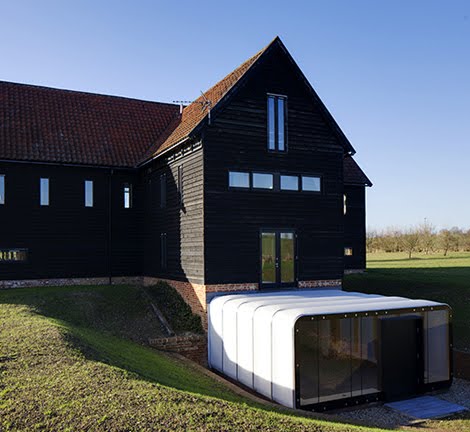

With the growing popularity of 'Pop Up' events like fashion shows, art exhibits. concerts, demos, promotional marketing, food fairs and the like, the idea of creating temporary and portable but sturdy inflatable structures that can be furnished, lit and branded is a smart one.


AirClad is the next generation of semi permanent and permanent architectural buildings developed by
Inflate, a company that designs and manufactures award-winning, architecturally stimulating stock structures that have been designed specifically to suit the portable and temporary events market.
A dome shaped AirClad structure used for Harper's Bazaar Melbourne Fashion Show

A commercial 12m x 12m AirClad pod with roof terrace to house the
Puma Social Club in Spain:


above: rendering for the AirClad structure shown below at Dwell on Design

The AirClad system is, in its simplest form, a structural skeleton with air inflated panels cladding it. The skeleton forms and monoqoque structure support the inflated cladding. The inflated panels offer insulated and structural properties to the finished building and especially allow for a new architectural aesthetic to be achieved. AirClad is a sealed pressure regulated system using very little energy to keep the whole structure in working order.


The AirClad system harnesses a combination of production and performance solutions from the sailing, events industry, contemporary engineering and architecture. The basic system utilises basic engineered ply wood joists, that carry an inflated membrane.


This membrane attaches to the frame via an aluminium extrusion with is fixed to the ply wood and allows the fabric membrane to slide into. The plywood joists have engineered spacers that once the cladding panels are inflated, are compressed with the whole structure being held together and cross braced by the inflatable panels. This basic building system makes for a water tight shelter. This shelter can be upgraded to have doors, or has the ability to be attached to traditional buildings.

The inflated panels can be clear or opaque, to offer solar insulation / heat retentions or just offer a great view. Everything is designed so that the whole structure can be left in place permanently or taken down and moved when finished with. The fabrics used offer a range of warranties from 5–60 years and the all the wood and aluminium elements would comfortably fall within these guidelines as well.
The Black House

The Black House sits on a 4m by 3m foot print, and reaches a max hight of 4m. The outer skin of the building is black to reflect the barn and the inner white allowing the lighting to have maximum reflection at night. The inner beams which we normally have left exposed as natural ply finish are in the case sprayed black also with a PU coating. This coating gives the beams an intriguing rubbery tactile feel to them.


Each end of the Black house is finished off with the AirClad signature float glass flush faces in graphite tint. The whole design just sits on the ground with no need for foundations and has an integral flooring system. In this design we have use an eco recoiled wood and plastic flooring as you may well find in any normal garden. This again keeps with the theme to use ready made materials which are local builder friendly.


The Black House can be installed in a day with a day to dress and fit out the interior. Whilst this project was for an exhibition the end use would see it ideally being used as a garden room, pool house, home office, play room, or best of all in good ole british style as a place to make home made wine and test it with your mates on a long summers evening. The Black Houses are made to order from £16,000.
The Suffolk Pod




The AirClad extension is built in the ground where there was an underground pond discovered when the main barn was being built. For this reason the AirClad is in fact at ground level from outside and required a lot more pre preparation to the site before they could erect the AirClad. In fact this project required 80% to 20% in terms of site to AirClad. This would not normally be the case if they were not needing to tank the pod and build in underground water pumps for high rain fall dispersal. This project cost £25,000 to complete.


All the structures are waterproof and can withstand heavy rain, snow and wind. The air pressure within the structure repels the water away at the seams and allows it to run to the ground.

With AirClad you can integrate many other applications such as lighting, sound, A.C., storage and as you do, the product takes on an even greater sense of space and your personality. You can tailor this to your own personality.

AirClad is not limited to commercial and residential venues and they have designs ongoing for hotels, airport terminals, even a caravan park. More recently they've have been looking at humanitarian applications for disaster areas and war zones.

To learn more about their commercial structures,
go here.
Nick Crosbie, Director
info@inflate.co.uk





























































